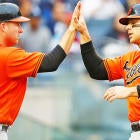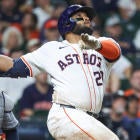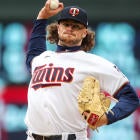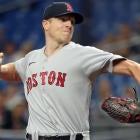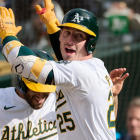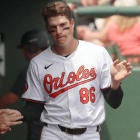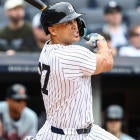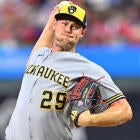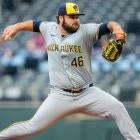Baseball is the same now and forever, but at times throughout history, the approach to the game changes enough to create dramatic shifts in individual performance.
And if last year is any indication, we’re entering one of those shifts now, specifically in terms of home runs.
A whopping 5,610 were hit across the majors last year, the most since 2000 -- two years after the great Mark McGwire/Sammy Sosa home run race and one year before Barry Bonds set the current single-season home run mark (with significantly less fanfare).
It was the height of the steroids era, in other words.
| Home runs hit by season | ||||||||
| 2016 | 5,610 | |||||||
| 2015 | 4,909 | |||||||
| 2014 | 4,186 | |||||||
| 2013 | 4,661 | |||||||
| 2012 | 4,934 | |||||||
| 2000 | 5,693 | |||||||
But that era was one of slugging behemoths accomplishing superhuman feats. Last year was more about spreading the love. A record 111 players eclipsed 20 home runs. This table gives you a pretty good idea of the changing distribution:
| Number of hitters to reach home run threshold by season | ||||||||
| | 20-29 | 30-39 | 40-49 | 50+ | ||||
| 2016 | 73 | 30 | 8 | 0 | ||||
| 2015 | 44 | 11 | 9 | 0 | ||||
| 2014 | 46 | 10 | 1 | 0 | ||||
| 2013 | 56 | 12 | 2 | 1 | ||||
| 2012 | 52 | 21 | 6 | 0 | ||||
| 2000 | 55 | 31 | 15 | 1 | ||||
There are a number of different theories as to why this change happened, from the way the ball is made to the way hitters are being coached to elevate the ball, to the way a new generation of hitters has learned to hit the low strike to, yes, the creation and proliferation of more sophisticated pharmaceuticals.
But all that’s showing up in the numbers, apart from the home runs themselves, is how much harder everyone is hitting the ball:
| Hard-hit percentage by year, according to FanGraphs | ||||||||
| 2016 | 31.4 | |||||||
| 2015 | 28.8 | |||||||
| 2014 | 29.1 | |||||||
| 2013 | 29.9 | |||||||
| 2012 | 28.5 | |||||||
That becomes a chicken-and-egg thing, though. Were they hitting more home runs because that percentage was higher, or was that percentage higher because they were hitting more home runs?
Fortunately, for Fantasy Baseball purposes, the why is irrelevant except to the extent that it tells us what to expect next. And since I can’t know the why, I’m only concerned with the how -- i.e., my response to the increase.
There are three basic schools of thought on the matter, all of which I’ll be covering here. Understand, though, that these apply mostly for categories-based formats, such as standard Rotisserie. In points-based formats, such as standard Head-to-Head, you’ll take production any way you can get it. Whether or not it’s in the form of home runs doesn’t really matter.
It was a one-year fluke, and we should ignore it.
The truest of analysts -- ones drives by pragmatism, reason and the scientific method -- would be most inclined to take this approach, adhering to the age-old excuse of “not enough data.”
But I’m following the lead of Dodgers president of baseball operations Andrew Friedman, a converted pragmatist who famously said after re-signing Kenley Jansen, Justin Turner and Rich Hill this offseason that “if you’re always rational about every free agent, you will finish third on every free agent.”
I want to win, baby, and I feel like working with outdated assumptions is a bigger impediment to that than going with the flow.
For starters, I’m not entirely sure a full season of data isn’t enough. It’s true that statistical oddities happen all the time in baseball, but more on an individual level than league-wide. And when it is league-wide, it’s not to near this degree. We’re talking a 14-percent increase in home runs from one year to the next. It took seven years to see that kind of decrease from the 2000 season, and it happened gradually.
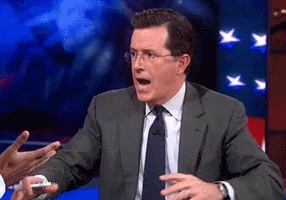
But even if it was a fluke, I’m not sure there’s a practical application given the way the home runs were distributed. Which of those 20-homer seasons were the anomalies and which were the legitimate breakthroughs? You could go case by case -- and we always do anyway -- but the number of obvious regression candidates wouldn’t even come close to pulling us down to 2015 levels.
Plus, there’s a reason I describe it as going with the flow. Like it or not, the draft pool has already been tainted by last year’s power explosion, with many of the unexpected 20-homer guys -- Jose Altuve, Jean Segura, Christian Yelich, etc. -- valued as if that’s their new baseline, which pushes some of the tried-and-true power sources further down in the draft.
Because the only 20-homer players who go early in drafts are the ones who contribute in batting average or stolen bases or who fill a premium position, you need to buy into that scarcity while you can, regardless of what you expect from those players power-wise.
It’s a matter of keeping up with the Joneses, knowing that many of the “true” power source will still be available to you later.
It’s the new normal so we should emphasize home runs on Draft Day.
This way of thinking makes sense on some level. If more home runs are available to everyone, then you need more to compete in the category, and so the same mile markers that might have worked for you in the past (e.g., two 30-homer guys and you’re good to go) no longer will. This table chronicling the middle-most home run total (sixth place of 12) from year to year in my longest running Rotisserie league sums it up nicely:
2016 | 282 |
2015 | 257 |
2014 | 202 |
2013 | 235 |
But again, because this phenomenon was so spread out, you’d almost have to go out of your way to get left out, targeting every Starling Marte, Jonathan Villar and Francisco Lindor you came across in the early rounds.
Obviously, someone still has to finish last in the category, but as long as you’re making a conscious effort to feed it throughout the draft, like you would any other year, you shouldn’t have too much trouble staying within striking distance.
It’s the new normal so we should de-emphasize home runs on Draft Day.
I’m the most drawn to this way of thinking, believing it’s the most adaptable approach even if it turns out to be wrong given that player values have already been influenced by last year’s home run totals. To clarify, it doesn’t mean consciously ignoring the home run category and trusting it’ll work itself out, but it does mean giving it different priority, particularly in the early rounds.
Those stud hitters who provide big power but nothing else? Maybe they’re not so worth it knowing how quickly stolen bases evaporate and knowing that late batting average help comes at the expense of most everything else.
Giancarlo Stanton is the clearest example of such a player, and we’re seeing him slip to the third round in part because of it. George Springer, though, has some of those same tendencies, his stolen base potential being mostly theoretical at this point. Brian Dozier, in addition to being a regression candidate, is basically a one-note player.
Edwin Encarnacion. Trevor Story. I could keep going. Obviously, there comes a point where the talent drop-off is so obvious that you have to draft these players, and you also have to take position depletion into consideration. But when you have the choice, you should go for the scarcer categories, especially since so many of those players provide home runs anyway. It’s why I wouldn’t dream of prioritizing Kris Bryant over Mookie Betts or Jose Altuve, and he’s not even such a liability in batting average.
When so many players are so capable in one category, you have to concede to supply and demand and fill the other ones first. It’s not that you don’t need the one. It’s just that you can come back to it. There isn’t a select group of players who will separate the haves from the have-nots, like with stolen bases. And that can be liberating, provided you know to take advantage.
And now you do.













